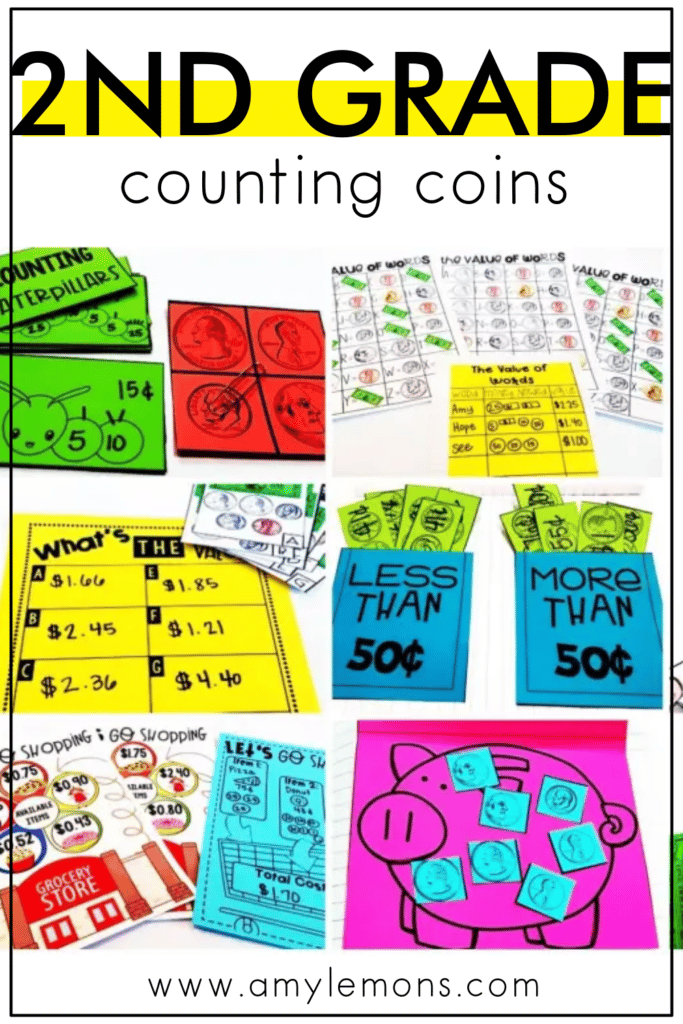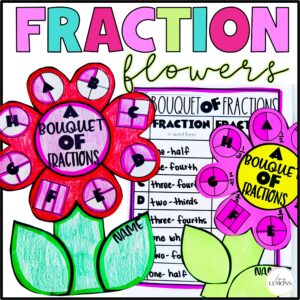

Let’s talk about money! We all want it. We all need it. But when it comes time to teach coins and money in the classroom, our kids often times struggle. They don’t see coins and bills on a regular basis if their parents are anything like me! They see credit and debit cards. They see online shopping. That’s just the way that the world is moving, but it is still so crucial to know the value of those bills and coins. And, we definitely want them to know how to count a collection of coins or bills if they ever do find themselves in that rare situation where a card isn’t used! So, let’s take a look at the progression from 1st to 3rd grades when it comes to money!
In 1st Grade, students begin by identifying and skip counting with coins. They should have background knowledge of coins from kindergarten, but some may arrive to your classroom without being able to identify the different types and values of coins. It’s very important to figure out where your students are because you don’t want to waste a whole week on identifying coins if the majority of your students can tell you the names and values of each coin! I see A LOT of coin coloring pages for 1st grade. There’s nothing wrong with that, but for those students that KNOW their coins, that becomes very boring and redundant! Let’s not waste time coloring different types of coins because our focus definitely needs to be on skip counting with those coins!
Activities shown above (Click HERE to see everything included):
-Coin Bubble Maps: The class assists in the making of bubble maps to define the attributes of each coin -Build a Bug: Students must determine what coins they would need to purchase each part of the bug. The students also find the total cost of the bug once put together. -Spin, Graph, Total: Students spin a coin, graph it, and skip count to find the total amount of pennies, nickels, and dimes. -Let’s Go Shopping: Students select an item to purchase and determine which coins they could use to purchase each item. -Change it Up: Students roll to see how many of each coin they need. Then students skip count to find the total of each coin type. -Race to 50 Cents: Students spin a coin and move forward that many spaces. Students are trying to reach 50 cents! -Quarter Kid: Students create 4 ways to make 25 Cents on the arms and legs of the Quarter Kid! -Make a Match: Students match the coins to the value and record that on their recording sheets. -Spend and Save Piggy Bank Hat: Students decide if the situations being described are examples of spending or saving. They color those by code and create a hat!
In Second Grade, students take what they know about identifying and skip counting coins, and add on to that knowledge. Different states vary in how they teach money in 2nd grade. Some states, like Texas, only have students count coins up to $1. Other states have students count bills and coins. Either way, it is good to know what your standards require so that you make sure your students are on target! Just like in 1st grade, 2nd graders don’t need to spend a ton of time on identifying coins. Work with the students that cannot identify coins, and move along with the others! Our time is more well spent when we are working on coin counting strategies rather than continuing to name the coins. It may take A LOT of practice, but they will eventually get it! It’s all about exposure, practice, practice, practice, and more practice… BUT, it is also about practicing in NEW and FUN ways that will keep our students motivated and engaged!
Activities shown above (Click HERE to see everything included):
-Counting Caterpillars: Students spin a coin and add that value to their caterpillar. Then students count the total value of the caterpillar’s body! -The Value of Words: Students build words using the coin code, then they determine the value of each word! -Roll and Count: Students use the key to roll and count coins. Once students have rolled 5 times, they determine the value of coins rolled! – What’s the Value? : Students look at the cards and count up the collection of coins shown. More/Less Than 50 cents: Students count the coins and determine if the value shown is more or less than 50 cents. Students sort the money strips into the pockets. -Solve the Problems: Students read the coin word problems and show their work to solve! -Let’s Go Shopping: Students pick the items they wish to purchase, then students determine the total cost of the objects they are purchasing. -Piggy Bank: Students build a collection of coins on their piggy bank flap, then students total the amount and write it underneath their piggy bank! -Race to $100: Students spin to see how much money to collect. They move forward that many spaces. Students will try to reach $100 before their partner!
In third grade, we focus on counting collections of money with bills and coins. We also dive deep into understanding the importance of financial literacy. We address financial literacy in all of our grade level units, but it is definitely a HUGE part of third grade. Students not only need to know how to count money, but they also need to understand a lot of terms such as: saving, spending, deposits, withdrawals, interest, credit, etc! So, students are taking those money counting skills and implementing them into real-life situations.
Activities Shown Above (Click HERE to see everything included):
-Money BINGO: Students show how to build the total shown on their BINGO piece. Students participate in a BINGO game, Calculate the Interest: Students have the cost of an item and the interest. Students roll to see how many days they must pay on the item. Students calculate how much interest will cost them in that amount of days! – Piggy Banks: Students keep a collection of coins and bills to use during the activities throughout the two weeks! – Fresh Fruit for Sale: Students choose the fruit they wish to purchase and show how they would pay for it! – What’s in My Wallet: Students have a total shown. They will draw how to make that total with bills and coins. – Savings: Students are given different scenarios. They have to keep record of the amount, even, and balance of their account. – Beach Bums: Students play a board-game to practice using cash or credit. – Financial Literacy Term Posters – Pet Shop Project: Students participate in a financial literacy project that will put all of their knowledge about financial literacy into practice! Students must run a pet shop and track all of their spending- planned or unplanned!
To find more blog posts about counting coins, click on the pictures below!


Hey, y’all! My name is Amy Lemons and I am passionate about providing students with both engaging and effective standards-based Math and ELA lessons.

Sample a day of Rooted in Reading with these lesson plans and activities for Reading Comprehension, Vocabulary, and Grammar!



3 Responses
Hi. I was just on Pinterest looking at your Timeline of Our Day pin and was wondering if you have the clocks, time cards, and title available for purchase?
Thanks,
Cindi Becker
2nd Grade
It is in my Time Unit found here: https://www.teacherspayteachers.com/Product/Its-About-Time-Telling-time-activities-199678
Amy,
These resources for learning about money are amazing! What I have noticed is that in my classroom, I have provided a lack of manipulative materials and students are confused about how to keep different coins straight. Your games like piggy bank and counting caterpillars would be a hit in my classroom!